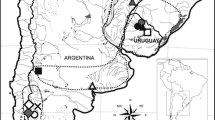Abstract
The dimensions of metaphase chromosomes and nuclear DNA contents were measured in eight species ofLuzula. The 2 C DNA contents ranged from 8.51 pg inL. purpurea to 0.55 pg inL. pilosa. Total chromosome volume shows a linear relationship with DNA content; however, the total chromosome length of the complement of the different species is approximately constant. Nucleolar volume and the number of chromocentres in the different species also show a relationship with DNA content. Taken together, these data suggest that while chromosome fragmentation could have generated the present-day range of chromosome numbers in the genus, there have also been changes in the total quantity of DNA with the result that species with similar chromosome numbers have different DNA contents. The relationships of DNA content with chromosome volume inLuzula and other genera are compared and the differences discussed.
Similar content being viewed by others
References
Bennett, M. D., andRees, H., 1969: Induced and developmental variation in chromosomes of meristematic cells. Chromosoma27, 226–244.
- andSmith, J. B., 1976: DNA amounts in Angiosperms. Phil. Trans. Roy. Soc. Lond. (in press).
Conger, A. D., andFairchild, L. M., 1953: A quick-freeze method for making smear slides permanent. Stain Technol.28, 281–283.
Evans, G. M., Rees, H., Snell, C. L., andSun, S., 1972: The relationship between nuclear DNA amount and the duration of the mitotic cycle. Chromosomes Today3, 24–31.
Halkka, O., 1964: A photometric study of theLuzula problem. Hereditas52, 81–88.
Jones, R. N., 1967: Cytological studies inSecale andAllium. Ph. D. Thesis, University of Wales.
Maher, E. P., andFox, D. P., 1973: Multiplicity of ribosomal RNA genes inVicia species with different nuclear DNA contents. Nature (New Biol.)245, 170–172.
Malheiros, N., andGardé, A., 1947: Contribuições para o estudo citológico do géneroLuzula Link. Agronomia Lusit.9, 75–79.
Malheiros-Gardé, N., andGardé, A., 1950: Fragmentation as a possible evolutionary process in the genusLuzula. Genet. Iber.2, 257–262.
—, 1951: Agmatoploidia no generoLuzula D.C. Genet. iber.3, 155–176.
Mello-Sampayo, T., 1961: Differential polyteny and karyotype evolution inLuzula: A critical interpretation of morphological and cytophotometric data. Genet. Iber.13, 1–22.
Nordenskiöld, H., 1949: The somatic chromosomes of someLuzula species. Bot. Notiser1949, 81–92.
—, 1951: Cyto-taxonomical studies in the genusLuzula I. Somatic chromosomes and chromosome numbers. Hereditas37, 325–355.
Pegington, C., andRees, H., 1970: Chromosome weights and measures in theTriticinae. Heredity25, 195–205.
Rees, H., andHazarika, M. H., 1969: Chromosome evolution inLathyrus. Chromosomes Today2, 158–165.
—, andJones, G. H., 1967: Chromosome evolution inLolium. Heredity22, 1–18.
Wagner, M. N. de, 1949: Subsidio para o estudo citológico do géneroLuzula D. C. Genet. Iber.1, 59–67.
Author information
Authors and Affiliations
Rights and permissions
About this article
Cite this article
Barlow, P.W., Nevin, D. Quantitative karyology of some species ofLuzula . Pl Syst Evol 125, 77–86 (1976). https://doi.org/10.1007/BF00986773
Received:
Issue Date:
DOI: https://doi.org/10.1007/BF00986773




